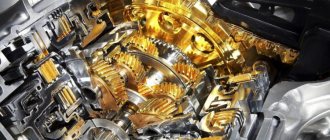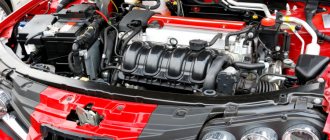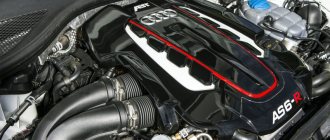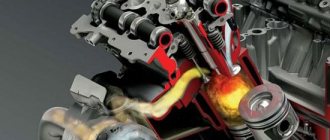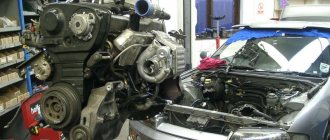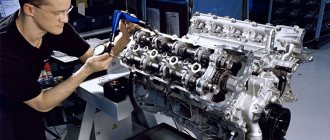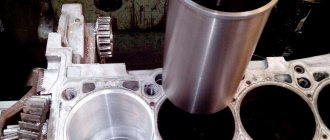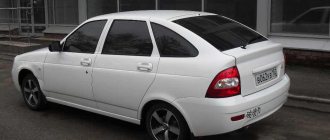The very first assembly of an internal combustion engine (ICE) dates back to 1885 and was carried out by German engineer Karl Benz. Since then, engineers have been constantly trying to improve the dynamics of engines. And the expression “engine displacement” is always heard, but not everyone knows what engine displacement is in reality and what parameters it consists of.
Engine volume is a design parameter of an internal combustion engine that determines its power.
In many countries, car taxation is determined by the displacement of their engines. For example, in Japan, owners of Kei Cars, which belong to the class of small cars and have an engine capacity of 0.66 cm cubic, do not pay road tax. In some countries around the world, tax legislation is structured so that the larger the engine displacement, the higher the road tax.
As for Russia, here the amount of road tax is determined by the number of horsepower, although these two parameters are completely interrelated. From all of the above, we can conclude that engine size is an indicator of the car’s power, as well as the solvency of its owner.
One of the promising vectors for the development of internal combustion engines design is the creation of engines with variable displacement, which is achieved by using a system for automatically shutting off several cylinders in partial engine load mode.
This technology is already used on some new American-made SUVs, thanks to which it is possible to save about 20% of the fuel mixture.
Currently, in the experimental stage, special engines with mechanical changes in the piston stroke are used. But internal combustion engines with variable displacement have already been used for some time as laboratory equipment, for example, when determining the octane number of gasoline using the “engine method”.
Engine displacement characteristics
The working volume of all types of engines is usually measured in cubic centimeters, or liters. It is according to these parameters that machines can be divided into the following categories:
- minicars (no more than 1.1 liters);
- small cars (from 1.2 to 1.7 liters);
- medium volume (from 1.8 to 3.5 liters);
- large-capacity (from 3.6 or more liters).
This division is quite arbitrary and concerns mainly engines running on gasoline. With diesel engines the situation is slightly different. The displacement indicator of power plants is one of the most important parts of a car. The more fuel mixture is placed in the combustion chamber, the more gasoline the car consumes. But along with fuel consumption, the power of the car also increases, because more fuel will produce a greater amount of released energy.
The disadvantages of large-capacity cars, in addition to fuel consumption, include their higher cost. So, it is logical to assume that much more materials will be required for its manufacture, and the requirements for the quality of manufactured parts will, accordingly, be much higher.
Engine number by VIN code
To find out the engine model by VIN code, you need to pay attention to the second part of the number (6 unique descriptive characters). These numbers indicate:
- Body type;
- Engine type and model;
- Chassis data;
- Information about the vehicle cabin;
- Type of brake system;
- Series of cars and so on.
To obtain the information of interest about the engine type by VIN number, the number itself will need to be deciphered. This is difficult for a non-professional to do, since the markings do not have a generally accepted notation system. Each manufacturer has its own symbol system, and you will need a specialized reference book for a specific car brand and car model.
You can obtain the necessary data about the engine model in simpler ways: many online automotive services (for example, Autocode) will do the decoding for you. You need to enter your VIN into the online request form and receive a completed report. However, such checks are often paid, as are consultations at service stations and MREOs.
At the same time, online spare parts stores (for example, Exist.ru), which are interested in increasing the growth of component sales, offer VIN decoding for free, and are ready to immediately offer you a wide range of spare parts for the engine of your particular car model.
Help: to determine the engine type, you can contact a service station. For a fee you can get all the necessary information there.
How to calculate engine size
Any power plant has a certain number of cylinders, and in order to calculate its total power, it is necessary to take into account the parameters of each of them.
In turn, the working volume of the cylinder is determined as the product of the cross-sectional area of the cylinder and the length of the piston stroke (from BDC to TDC).
So how do you find out the total engine volume? To do this you need to make a few simple calculations:
- For example, if a car has an inline four-cylinder engine, and the volume of each individual cylinder is 499 cubic centimeters, we should multiply this number by four.
- As a result, we will get a value that determines the displacement, in our case it is 1996, then we round it to the nearest whole value. In our case it is 2000, then we divide this value by 1000, and this means that this engine will have a volume of two liters.
What does displacement affect?
As already mentioned, the larger the cylinder volume, the more fuel it can burn in one stroke. Accordingly, its combustion energy will be higher. As a result, engine power and dynamic characteristics of the car increase.
However, we should not forget that big engines have a big appetite. So, if a one and a half liter gasoline power unit in the urban cycle consumes an average of 9-10 liters of fuel per 100 km, then a two-liter engine will require 12-13 liters of fuel. On the highway the difference is less, about 6.5-7 liters versus 8-8.5.
The reason is that while idling, a larger engine also consumes more gasoline, while while driving it allows you to accelerate the car faster to the required speed, i.e. The operating time in uneconomical mode is reduced.
The formula “more volume – more power” is true for passenger cars. Trucks take a slightly different approach. Large volume does not necessarily mean a "herd of horses" under the hood, since for these cars the more important characteristic is large torque in all crankshaft speed ranges.
Thus, the KamAZ-54115 tractor has a power unit volume of 10.85 liters (the volume of only one cylinder is comparable to the displacement of a small car engine), while its power is only 240 hp. For comparison, the BMW X5 with a three-liter diesel engine develops 218 hp. In fairness, it is worth noting that the latest generation KamAZ heavy trucks are equipped with more modern engines with a volume of 11.76 liters and a power of up to 400 hp.
The principle of operation of the internal combustion engine
Operating principle of an internal combustion engine:
- The combustion chamber of the power unit is filled with a fuel mixture (gasoline with air). The chamber is designed so that it has a movable element (piston).
- Then, using a special device called a “spark plug,” the fuel mixture ignites.
- The energy released as a result of the “explosion” pushes the piston down, which in turn transmits the movement to the crankshaft, which, through various gearboxes, begins to spin the wheels.
This is the simplest description of the operation of the engine; in fact, there are a huge number of nuances, but it also allows us to answer the question of how to find out the volume of a gasoline engine.
Now it is clear that the volume of any engine is the total value of all combustion chambers of the engine. What does this indicator affect? First of all, on the power of the car. Although modern cars are increasingly using turbocharging, which allows inventors to increase power while leaving the volume of the combustion chamber unchanged.
Engine Model Number
You can also obtain information about the engine model by the number, which is indicated directly on the unit - under the hood, closer to the windshield. Only older American-made models do not have it there, but even on modern cars it is not always easy to find and read it - dust, dirt, soot and corrosion take their toll.
The engine number is 14 characters:
- The first 5 characters are descriptive information about the base model, modifications of a particular car and climate class.
- 6th symbol – Latin letter A (diaphragm clutch) or P (recirculation valve).
- The last 8 characters are index information (month and year of manufacture, individual serial number).
To determine the engine model, the first three digits of its number, which characterize the indices of the base model and configuration, are of informational value.
By the engine number you can determine its model. But only if you navigate the information and know how to then use it. If the features of car markings are unclear to you, a more suitable way to get the information you are looking for would be an online search specifically by VIN code.
How to increase engine size
This question is often asked by car owners who have set themselves the goal of increasing the power of their “iron friend” at any cost.
As you know, a car engine consists of several cylinders, they are located in a single block (cylinder block). There is a piston inside each cylinder. And this entire system together is called the combustion chamber and determines the displacement of the power plant.
It is quite simple to independently calculate engine volume; for this there is a formula that was described above.
As a result, how can you increase engine power yourself? Typically, there are several ways to solve this problem. It all depends on how much you want to increase the power output of the engine and of course on the size of your wallet:
- The simplest and cheapest option is simply boring the cylinder block to increase the combustion chamber. In this case, your costs will only be associated with the purchase of new pistons of larger diameter.
- A more expensive option is to replace the “original” crankshaft with a shaft with a larger crank radius. Well, since the diameter of the connecting rods will increase, you will have to change the entire piston group. After this procedure, the stroke of the pistons will increase, and, accordingly, the displacement of the power unit will become larger.
What method to use to increase the power of a car is a personal matter for everyone. But it is worth remembering that boosting the engine at home is simply unrealistic. This requires special equipment, and most importantly, highly qualified specialists. So, if you still decide to take such a step, you have a direct route to a tuning agency.
Calculation of internal combustion engine volume with a calculator
To calculate the volume of the engine you are interested in, you need to enter 3 numbers in the appropriate fields - the result will appear automatically. All three values can be found in the car’s passport data or technical data. characteristics of a particular part, or a caliper will help determine what piston volume.
Thus, if, for example, you find that the volume is 1598 cm³, then in liters it will be designated as 1.6 liters, and if the number is 2429 cm³, then 2.4 liters.
Long-stroke and short-stroke piston
Also note that with the same number of cylinders and engine displacement, the cylinder diameters, piston strokes and power of such engines may also be different. An engine with short-stroke pistons is very power hungry and has low efficiency, but achieves great power at high speeds. And long-stroke ones are located where traction and efficiency are needed.
Therefore, the question “how to find out engine size by horsepower” can be given a firm answer - no way. After all, although horsepower has a connection with engine volume, it will not be possible to calculate it from them, since the formula for their relationship also includes many different indicators. So the cubic centimeters of an engine can be determined solely by the piston parameters.
The concept of cylinder displacement
This indicator is the value between the extreme positions of the piston in motion. The volume is filled with the fuel mixture during the process of injecting fuel and moving the piston. Being in the upper position, the piston forms a free value, which is, in fact, a combustion chamber.
To calculate the volume of the cylinder, you will need to add the operating parameter and the size of the compression chambers. The compression level serves as a determining parameter for the degree of compression of the mixture in the cylinder. The power of the power plant depends on this indicator.
How to install a motor with other technical characteristics correctly?
It is very difficult, expensive, but possible. True, it is so expensive that it is possible to consider buying a more powerful car with a native engine rather than making such changes.
The first thing that needs to be clarified is that a car is a structural system consisting of units, components, parts and other parts. The design of the car is regulated by the manufacturer, and making changes to it is simply prohibited by the State Traffic Safety Inspectorate in paragraph 7.18 of the Basic Provisions of the Traffic Regulations. But in order for changes to be made, they must be supported by testing to prove that the changes are safe to drive on the road. The manufacturer of your car has carried out such tests, but only with the engine that is installed from the factory.
If you install a more powerful engine with a larger displacement, speed, and so on - other characteristics, then you need to officially make changes to the design with confirmation of the safety of such changes. Without this permit you cannot get it from the traffic police!
How to make changes with a more powerful motor?
As we wrote above, this is quite difficult to do. Complete instructions for making changes to the design are described in our special article about this. In short, you need:
- obtain formal permission from the traffic police to make changes (it is issued to everyone),
- undergo a preliminary examination to determine the possibility of making changes; the examination may decide, among other things, that a new engine with more power cannot be installed on this car model at all - other units do not correspond (box, transmission, suspension, for example),
- if the examination is successful, then contact the traffic police again and submit an application for amendments with the conclusion of the preliminary examination,
- make changes - install a replacement motor - in a certified organization,
- receive a declaration of the changes made,
- pass the examination again,
- pass a technical inspection,
- register changes with all documents with the traffic police.
Only after this can you officially drive with a non-original engine, which is more powerful than the stock one.
The cost of the entire procedure for experts varies depending on the model of the machine, but ranges from 60 to 100 thousand or more rubles.
